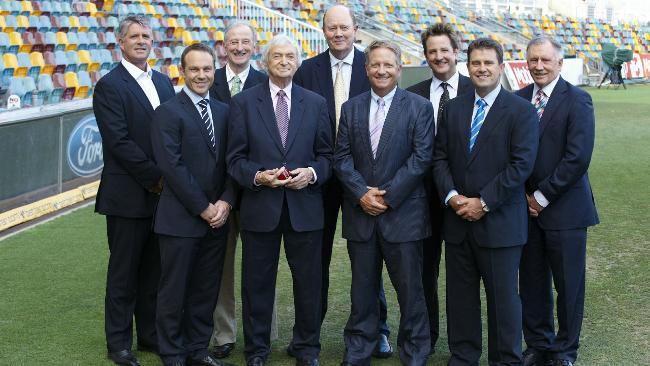Not just cricket
Nine has got to bring a whole lot of style to its coverage of the beautiful game if it's going to keep viewers watching through the summer

Nine has got to bring a whole lot of style to its coverage of the beautiful game if it's going to keep viewers watching through the summer
'THE slow-motion replay doesn't show how fast that delivery was really travelling," Richie Benaud once said -- one of his gems, spun quietly out of the side of his mouth.
The great leg-spinner turned magisterial commentator is 80 now, but thankfully we have at least another year of him delivering those Stoppardian moments. "A cricket ground is a flat piece of earth with some buildings around it," was another deceptive verbal break I still remember. And already this year he's as droll, elliptical and perceptive as ever.
Benaud has returned with the Nine commentary team of Bill Lawry, Tony Greig, Ian Chappell, Mark Taylor, Ian Healy, Michael Slater, Mark Nicholas, James Brayshaw and Shane Warne. The insightful and charmingly garrulous Adam Gilchrist, former Australian wicketkeeper, will be a special guest commentator throughout the season.
There's a lot at stake this year. A recent Cricket Australia discussion paper revealed TV audiences had tumbled 24 per cent during the past decade, that there was now a significant drop-off in players once they reached age 13, and female fans were turning away from the game. Nine has 39 days of live cricket broadcasting left this summer on its Wide World of Sport, including the Ashes series against England starting on Thursday, to try to turn the game around. As they say, it's a big ask.
The season has already begun with four limited-overs matches against Sri Lanka. It's started well, even though the crowds were thin and ratings poor, but the Ashes coverage should be terrific TV, another nail-biting round in the oldest battle in sport.
Nine has been at the forefront of cricket broadcasting for decades, though until recently it was somewhat becalmed. For a time, as the new century unfolded, Nine's cricket coverage looked like a TV heavyweight that was always moving but never getting anywhere; its commentary team was a convalescent home for former captains who happened to once have been mates of Kerry Packer. Nine took its market for granted, assuming that viewers' loyalty to the game was limitless, their goodwill unbounded.
The level of Nine's rhetorical presentation was dreary, choked by a tired layer of former player jargon and references to glory days most viewers had never known. The commemoration of the past turned increasingly risky when it was becoming obvious cricket was a sport that needed to quickly find a role for the future. Apart from Benaud's droll one-liners, there were few grammatical flourishes, the jokes were predictable, there was little colloquial energy and journalism was noticeable only by its absence.
But the addition of Slater, Warne and now Brayshaw, an experienced radio and TV personality, has added new energy and vigour to the call over the past couple of years, and an intimacy with the players of the new era. So far there's been more honesty and simplicity in the commentary, mainly led by the newer presenters. It's far more tightly focused, with a touch of bloody-mindedness from Slater, stylish brevity from Nicholas, and the usual grace and wisdom from Benaud; and, somehow, Taylor's diction seems to have improved.
Benaud is obviously enjoying the tighter focus, reserving Pinter-like silences for any query his intelligence rejects as unworthy of comment. Slater riffed about the new technology that checks players' heart rates during a recent one-day game, and spoke enthusiastically of spin classes and supervised aerobic exercises. Benaud waited out one of those long pauses of his and then: "We don't do gym; we do walking," he quietly admonished.
I'm enjoying the technical presentation as well as the re-energised commentary. In recent years Nine's cricket boffins have given us Hawk Eye, originally a technology used for brain surgery and missile tracking, which follows the path of every ball bowled. There are also the Speed Gun, measuring bowling speeds, the Snickometer, and the more recently military-developed Hot Spot, which shows the negative image of any incident where ball hits bat, glove or pad. There's now also the GatorTracker, checking player's heart rates, which so excited Slater and totally lost Benaud ("Now, don't worry too much about all this at home," he muttered to viewers).
During the one-dayers, Nine introduced smart technology that measures the carry of the batsmen's hits, the big sixes, the screen lighting up with three-dimensional graphics and matching sounds. There also seems to be a camera device that somehow shows the shot from the batsman's point of view, some technology that is still being worked on, according to Greig, by "the little man in the truck outside the ground".
Nine is finally so much closer to cracking what it feels like to attend the event but still have a multitude of information about the game and its participants presented to us with the rush of cyberspace. It's a big call, but the Americans have been doing it for years. Watching Fox Sports' coverage of the World Series baseball recently was astonishing, as it has for years been a controlled cacophony of sound and visual spectacle that authentically mimicked the confusion and excitement of a live sporting event.
This is Nine's big problem when it comes to reinventing cricket for a new audience. Nine needs to find ways to prevent advertising undermining the broadcast's inherent liveness and spontaneity. Last year seemed really sloppy, with seemingly little attempt to punctuate each act with an appropriate "out" cutting to commercials. The shorter games this year have been no better, at times being almost unwatchable. There's two and a half minutes of play when the spinners bowl and then a welter of advertising for fast food, lotteries, beer, cut-price airlines and hardware barns, or at least it seems that way.
The in-house promotions, voiced by the commentators, once a bit droll, are now desperately crass. They try hard but they're former players, not actors. No matter how straight-facedly they mouth the scripted words for Nine's shows, irony, and sometimes sarcasm, cuts through. I think it's the use of advertising (including the almost endless cross-promotion) as much as anything that has affected Nine's version of the game. It's not only the incessant commercials: there is advertising all over the ground, on the players' and umpires' clothing, plugs run along the bottom of the screen, and there are annoying sponsored trivia quizzes.
We've always tolerated advertising as part of the agreed to, almost moral, contract we have with commercial TV: the channels bring us free shows and we agree to put up with their endless ads. But now there's customer-friendly pay TV, internet downloads and ad-skipping recorders, and we've become far more impatient about commercial interruptions to our viewing.
But it's the Ashes this week and I'll still watch, even if ABC radio is on in the background. It's in the DNA of many of us to be part of the contest, even if it's excruciating to watch at times. I was in Cardiff for last year's first Ashes test at Sophia Gardens, a lovely ground surrounded by parklands. Flags waved from cars, hooters blew, delighted kids with painted faces whooped and hollered, the Barmy Army of England supporters marched arm in arm, singing its loony songs. A crumpled-looking fellow in an Australian supporter's cap stood near the ground on a little bridge with a sign around his neck: "Ticket please, will swap for sister."
The Ashes on Nine, despite the cacophony of cheap commerce, will be something to swap your other one for.
'THE difference between a fairytale and a fisherman's story is that a fairytale starts with 'Once upon a time', a fisherman's story with, 'This is no bullshit but ...' "
That's how this lovely valedictory episode of Deadliest Catch: The Phil Harris Story, a one-hour special documenting the biography of one of TV's most unusual stars, starts off.
Its subject is caught talking to camera before exploding in a typical stream of profanity. Harris was better known as "Captain Phil", the salty, hard-living sea captain on Discovery Channel's top-rated blue-collar adventure series, one of the world's most popular TV shows. The series follows the now well-known captains and crews of six crab-fishing vessels doing one of the most perilous, and lucrative, jobs in the world, fishing for king and opilio crab in the frigid Alaskan waters.
Produced by Thom Beers, Deadliest Catch, now in its sixth season, is possibly the most famous documentary-style reality series ever filmed. It's certainly the most dangerous and, cinematically, probably the most beautiful: all those bright orange slickers beneath dazzling yellow sodium lights in a black, black ocean. The guys wearing them endure sub-zero arctic weather, winds over
129km/h and turbulent seas with waves the size of four-storey buildings, all on three to four hours of sleep each night. Almost 4000 litres of water crashes on to the deck every 30 seconds, freezing as it hits the boat. Each is rigged with two fixed cameras covering the deck and a smaller "captain's cam" in the wheelhouse, focused on the skipper. Two Discovery Channel cameramen are embedded with each crew, stalking them day and night with hand-held cameras.
The same scarred boats turn up weekly in the series, their ratbag crews like turbulent characters in an episodic seafaring novel. There are great characters here, attractively vigorous personalities, some amoral and unsavoury, human enough to be likable, brave enough to be admirable and funny enough to be laughable.
And Captain Phil -- gravelly voiced and cranky, often so exhausted he fell asleep at the wheel of his ship, even after refuelling with caffeine, nicotine and stress, as well as dozens of cans of Red Bull -- was one of the most distinguished.
The heavily tattooed fisherman with the well-documented chain-smoking lifestyle never anticipated that his stroke on board the MV Cornelia Marie in January this year would be captured on camera -- or that his hospitalisation and eventual death from a pulmonary embolism would feature through recent episodes of the series. It was the first time an unscripted show, the most realistic of reality TV series, actually featured the death of one of its stars, and it's been done with all the grace and sobriety of a Joseph Conrad short story.
The Phil Harris Story is the show's final farewell to Harris, crammed with interviews with his fellow captains and deckhands, memorable Phil moments from the past six seasons, and never-before-seen footage from behind the scenes. If you haven't watched the show, it's a wonderful introduction; if you have, then crack a couple of cans of Red Bull and say goodbye to the captain.
Deadliest Catch: The Phil Harris Story, Wednesday, 9.30pm, Discovery.
The Ashes, Thursday, 10.30pm AEDT, Nine.


